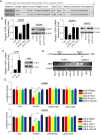TCRP1 activated by mutant p53 promotes NSCLC proliferation via inhibiting FOXO3a
- PMID: 35459265
- PMCID: PMC9033812
- DOI: 10.1038/s41389-022-00392-9
TCRP1 activated by mutant p53 promotes NSCLC proliferation via inhibiting FOXO3a
Abstract
Previously, our lab explored that tongue cancer resistance-associated protein (TCRP1) plays a central role in cancer chemo-resistance and progression. Absolutely, TCRP1 was significantly increased in lung cancer. But the mechanism is far from elucidated. Here, we found that TCRP1 was increased in p53-mutant non-small-cell lung cancer (NSCLC), comparing to that in NSCLC with wild type p53. Further study showed that mutant p53 couldn't bind to the promoter of TCRP1 to inhibit its expression. While the wild type p53 did so. Next, loss-and gain-of-function assays demonstrated that TCRP1 promoted cell proliferation and tumor growth in NSCLC. Regarding the mechanism, TCRP1 encouraged AKT phosphorylation and blocked FOXO3a nuclear localization through favoring FOXO3a ubiquitination in cytoplasm, thus, promoted cell cycle progression. Conclusionly, TCRP1 was upregulated in NSCLC cells with mutant p53. TCRP1 promoted NSCLC progression via regulating cell cycle.
© 2022. The Author(s).
Conflict of interest statement
The authors declare no competing interests.
Figures








Similar articles
-
TCRP1 induces tamoxifen resistance by promoting the activation of SGK1 in MCF‑7 cells.Oncol Rep. 2020 Jun;43(6):2017-2027. doi: 10.3892/or.2020.7577. Epub 2020 Apr 3. Oncol Rep. 2020. PMID: 32323833 Free PMC article.
-
Epigenetic silencing of miR-493 increases the resistance to cisplatin in lung cancer by targeting tongue cancer resistance-related protein 1(TCRP1).J Exp Clin Cancer Res. 2017 Aug 31;36(1):114. doi: 10.1186/s13046-017-0582-5. J Exp Clin Cancer Res. 2017. PMID: 28859669 Free PMC article.
-
TCRP1 transcriptionally regulated by c-Myc confers cancer chemoresistance in tongue and lung cancer.Sci Rep. 2017 Jun 16;7(1):3744. doi: 10.1038/s41598-017-03763-0. Sci Rep. 2017. PMID: 28623290 Free PMC article.
-
TCRP1 promotes NIH/3T3 cell transformation by over-activating PDK1 and AKT1.Oncogenesis. 2017 Apr 24;6(4):e323. doi: 10.1038/oncsis.2017.18. Oncogenesis. 2017. PMID: 28436990 Free PMC article.
-
TCRP1 expression is associated with platinum sensitivity in human lung and ovarian cancer cells.Oncol Lett. 2017 Mar;13(3):1398-1405. doi: 10.3892/ol.2016.5534. Epub 2016 Dec 27. Oncol Lett. 2017. PMID: 28454268 Free PMC article.
Cited by
-
Metformin Suppresses Stemness of Non-Small-Cell Lung Cancer Induced by Paclitaxel through FOXO3a.Int J Mol Sci. 2023 Nov 22;24(23):16611. doi: 10.3390/ijms242316611. Int J Mol Sci. 2023. PMID: 38068934 Free PMC article.
-
The roles of protein ubiquitination in tumorigenesis and targeted drug discovery in lung cancer.Front Endocrinol (Lausanne). 2023 Sep 19;14:1220108. doi: 10.3389/fendo.2023.1220108. eCollection 2023. Front Endocrinol (Lausanne). 2023. PMID: 37795365 Free PMC article. Review.
References
-
- Tanaka F, Ishikawa S, Yanagihara K, Miyahara R, Kawano Y, Li M, et al. Expression of angiopoietins and its clinical significance in non-small cell lung cancer. Cancer Res. 2002;62:7124–9. - PubMed
LinkOut - more resources
Full Text Sources
Research Materials
Miscellaneous

